Art
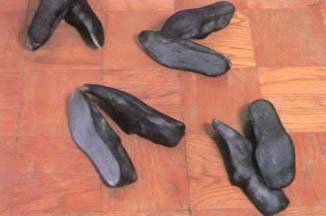
Journey between cultures
Artists inspired by life in Iran and America
By Maryam Ovissi
May 14, 1999
The Iranian
Many Iranian artists in the United States have become integrated into
the contemporary art world. One of the most well-known is Shirin
Neshat, who has presented her Iranianess with a language that has gained
wide respect and appreciation.
In this article, I will present five other well-known and upcoming contemporary
Iranian artists in the United States. Of course, there are numerous others
that could be mentioned, but Seyed Alavi, Hadi Tabatabai, Afarin Rahmanifar,
Aylene Fallah and Maryam Javaheri will provide a glimpse as to the range
of art and styles being created.
Art categorized according to a specific cultural affiliation be judged
within cultural paradigms or what the culture connotes. The primary goal
of this article is not to present what is similar among the five Iranian
artists, but to reflect the diversity of their work and various forms of
inspiration these artists find in life and Iranian culture.
Since 1996 I have founded and organized an annual Iranian exhibition,
Evolving Perceptions, sponsored by the Iranian American Cultural Association
and Evolving Perceptions, Inc. in Washington DC. I am continuously impressed
by the number of submissions and range of work being created by Iranian
artists in the United States.
Many of the artists are inspired through their cultural heritage, while
others create because of their sheer desire to make art. The followings
based on personal interviews with each of the artists.
Aylene
Fallah, Washington DC area:
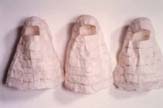 When one meets Aylene Fallah, she greets you with
a warm optimistic smile, bright eyes and a voice that always carries a
smile. Yet, her work is heavy, tragic and very depressing. Internally,
Fallah is processing the suffering and tragedy of the human condition.
The manifestations of her thoughts are delicate, contemplative and beautiful
works of art.
When one meets Aylene Fallah, she greets you with
a warm optimistic smile, bright eyes and a voice that always carries a
smile. Yet, her work is heavy, tragic and very depressing. Internally,
Fallah is processing the suffering and tragedy of the human condition.
The manifestations of her thoughts are delicate, contemplative and beautiful
works of art.
Fallah is a young and promising artist. She received her Bachelor of
Fine Arts from Virginia Commonwealth University in May 1998. Her concentration
was sculpture.
Motivated through the themes and subject matters she chooses to explore;
Fallah seeks out materials or processes that will allow her to creatively
explore the topic(s). Most of the work explores the human experience and
condition, primarily centered around tragedy. She tackles topics that are
relevant to Iran and expands them- making them universal. Her choice in
subject matter also correlates to questions and issues in defining her
own identity and her Iranian heritage.
For example a recent series of sculptural works explore veils, maghnaehs
and chadors. She has created delicate and ghost-like life-size sculptures
out of tea bags depicting chadors and maghnaehs. Her initial interest in
tea bags emerged from her personal inquiry about the importance of tea
in Iranian culture.
Her fascination of this sacred liquid in Iranian culture led her to
study and look at tea and tea bags through different facets. She says she
uses the tea bags (not the tea leaves), because they symbolize the filtering
process where as something enters - something leaves. The tea bags are
a metaphor for the veil, where perceptions are filtered in and out through
the veil, chador or maghnaehs.
Fallah has also been working on a series that deals with the tragedy
of war; specifically the Iran-Iraq war. These works appear to be two dimensional,
but upon close inspection the viewer finds layers of transparencies, gauze
and other raw materials.
How does a viewer approach Fallah's works when it alludes heavily to
Iranian culture and history? She remarks that "people bring their
own experiences to a work of art."
For instance, at the opening of one of her shows, a viewer who was looking
at her series about the Iran-Iraq war, remarked that he had never seen
such strong representations of the Vietnam War. He also said that he found
it interesting that she used the Arabic script beneath these images although
the war took place in Vietnam. Fallah did not reveal to him that the images
were about another war and human tragedy, because the works of art were
about the same human condition of war, suffering and death.
I asked Fallah about the reaction she receives from individuals who
are not familiar with Iranian culture. "If people do not have a connection
with Iranian culture, they tend to deal with the work on a material or
process-orientated level," she says. "The dwell more on the materials
I use, than the topic or theme of the work."
Fallah is the youngest artist presented in this survey and will certainly
make her mark in the arts as she progresses.
Seyed Alavi,
California
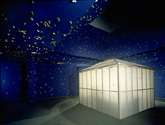 Seyed Alavi is a conceptual artist. His works
are manifestations of his exploration of ideas and concepts. He does not
use any specific materials or work in a particular style or size. He is
best known as a public artist, creating large and small projects for various
communities and in non-traditional settings.
Seyed Alavi is a conceptual artist. His works
are manifestations of his exploration of ideas and concepts. He does not
use any specific materials or work in a particular style or size. He is
best known as a public artist, creating large and small projects for various
communities and in non-traditional settings.
Alavi does not believe that art speaks only to a few. Art is a universal
language that should be enjoyed and utilized by all. Therefore, Alavi wants
his work to be accessible. Alavi's hopes about his art is reflected in
a quote by Henry David Thoreau : "I want my writing to be as clear
as the water; to see through without my being in between in any way."
Alavi defines his art as visual poetry. He describes it as a building
comprised of various layers. The various components or the combination
of the components attract different types of people and experiences. He
also defines poetry as a dialogue among people soaked in love. His favorite
poets are Attar, Mahmood Shabistari and Rumi.
In an article, Alavi wrote: "By creating art works which are engaging
and that are formally and metaphorically available to the general public,
in short by creating visual poetry, I believe that it is a possible to
create quiet places in which we can begin the reintegration of deep and
ultimate meaning into our lives." ("The Garden of Secrets and
Visual Poetry: The Art of Seyed Alavi" ARTS Magazine.)
Alavi began his higher education at San Jose State University as an
engineer and later made a transition to art. He graduated with a degree
in graphic design. He cannot pinpoint an event that caused him to shift
towards art. He continued his education at San Francisco Art Institute.
Alavi has mostly created art for non-traditional spaces such as highway
concrete walls, libraries and even mountain sides. In the last two years,
he has been creating more work for galleries and museums. He says most
of the works he creates for the gallery and museum environments deal with
ideas and concepts inspired by Sufi or mystic poets.
His most recent exhibition at the de Saisset Museum at Santa Clara University,
California, called The Canticles of Ecstasy, is comprised of five site-specific
installations. This exhibition draws completely from his multilayered definition
of art, where each work is part of a whole. When one first enters the de
Saisset Museum, they are greeted by the first installation "Search"
comprised of large Farsi calligraphic letters painted on the foyer wall
which read (translation):
There is water in the well,
yet we wander about complaining of thirst;
The Beloved is in the house,
yet we roam around the world in our search
The foyer also houses a fountain, which adds the continuous sound of
floating water, and a mirror located on the upper mezzanine.
Another installation, "Union", houses a collection of mystical
love poems translated into English and written on Post-Its arranged along
the gallery wall - creating a pattern of waves.
Hadi Tabatabai,
California
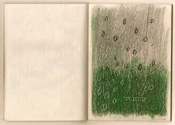 When I first encountered Hadi Tabatabai's
works in 1995, they were full of organic figurative forms filled with fantastic
layered colors. His early work spoke more of his world, of his life, of
his stories. Then a few years ago, Tabatabai decided that his stories carried
no importance and what was significant to him was the creative process.
Two years ago his work took a dramatic turn and he began creating works
on paper and canvas covered in neutral colors and lines.
When I first encountered Hadi Tabatabai's
works in 1995, they were full of organic figurative forms filled with fantastic
layered colors. His early work spoke more of his world, of his life, of
his stories. Then a few years ago, Tabatabai decided that his stories carried
no importance and what was significant to him was the creative process.
Two years ago his work took a dramatic turn and he began creating works
on paper and canvas covered in neutral colors and lines.
Recently, he has begun drawing, carving and weaving delicate lines and
patterns. His work is spiritual in that it allows one to remove herself
from the immediate material world (from all that is familiar) and become
mesmerized in line and pattern. This feeling of spiritual emancipation
is also experienced through the patterns of Persian carpets or in the tile
work of mosques.
Tabatabai calls himself a mark maker, creating patterns and textures
through the use of simple lines and neutral colors. He seeks to be pure
and honest with himself and the audience. Although, he finds this to be
challenging at times, "because what may have been true yesterday may
not be true today." But we are sometimes misguided by comfort and
therefore, Tabatabai continuously tries to be truthful with himself and
others.
As a child, Tabatabai did not take art seriously. As he grew older,
he became aware of its presence and importance. For six years he worked
in the industrial technology sector after receiving his bachelor of science.
In 1977, he moved to Los Angeles, and began drawing and sketching. With
the support and encouragement of his friends, he pursued his interest.
For two years, he studied oil painting with Payman, at Payman's Art Studio
in Los Angeles. Later, he moved to San Francisco. In 1995 he obtained his
bachelors of art from San Francisco Art Institute.
He left Iran at the age of 13, but hopes to return in the next few years.
I asked him what he felt was Iranian about his work. He answered, "The
fact that I am making them and that I have Iranian sensibilities. Many
have said that my work seems Islamic because of the patterning."
Patterns found in Iranian textiles and rugs inspire him. One of his
most recent works include the use of string. He began to play with string
less than a year ago and wove a grid out of knots (about 3 x 4 feet). He
attached the string grid to a previously painted gray canvas. The feeling
of awe is overwhelming when one views the delicate nature of the weaving
laying flat against the gray canvas.
A biography about Tabatabai would not be complete without acknowledging
the importance of music. For several years, he has been studying the accordion.
He says one of the reasons he enjoys the accordion is because the whole
body is involved in playing this instrument. The rhythms and patterns he
hears in music and sees on a sheet of music inspire him to bring the same
types of sounds and rhythms into his work. Currently, Tabatabai resides
in Berkeley, California, and continues to create art.
Maryam
Javaheri, New York
 Maryam Javaheri has had the longest artistic career
of the five artists presented. She received her fine arts degree from Tehran
University and continued her advanced education at New York University
and the Art Students League of New York in the early 1960's. Her impressive
list of private tutorledges includes important American artists such as
Ad Reinhardt, Adolf Gottlieb and Will Barnett. Today, some of the artists
she admires are Jackson Pollock, DeKooning and Helen Frankenthaler.
Maryam Javaheri has had the longest artistic career
of the five artists presented. She received her fine arts degree from Tehran
University and continued her advanced education at New York University
and the Art Students League of New York in the early 1960's. Her impressive
list of private tutorledges includes important American artists such as
Ad Reinhardt, Adolf Gottlieb and Will Barnett. Today, some of the artists
she admires are Jackson Pollock, DeKooning and Helen Frankenthaler.
Javaheri has been aware of her relationship with art from a very young
age. In elementary school, teachers became aware of her artistic abilities
and encouraged her parents to help her pursue this path.
Her art before the 1960's were mostly figurative. Later, in the mid
1960's she turned to non-objective abstract works of art. Today, she continues
to create paintings and collages using clean vivid colors, strong forms,
shapes and continuous fluid movement. Her work allows the viewer space
for interpretation. Javaheri has no mission or purpose in creating art.
Even in her creative process, she doesn't plan her work ahead of time.
Instead she simply sits in front of the canvas and creates. The colors
and composition are composed through an impromptu effort.
Javaheri exhibits in Iran every two or three years. Her past exhibitions
in Iran were held at Gallery Seihoun, Gallery Litho and Talareh Gallery.
When in Iran, she says that her work is well received mostly by foreigners
and those who have studied abroad. In Iran, she says, people do not have
enough access to contemporary art. This has kept the arts from moving forward.
Javaheri resides in New York with her husband. She continues to create
art and periodically visits Iran.
Afarin
Rahmanifar, Connecticut
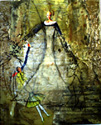 Afarin Rahmanifar's works explores the issues of
beauty and femininity. Non-traditional materials merge with themes of beauty
and femininity - the ideal Persian beauty versus American beauty. She uses
American icons such as Marilyn Monroe and Barbie dolls with their blond
hair and blue eyes juxtapositioned with Persian icons, such as Qajari women
with dark eyes, dark eyebrows and long dark hair. Her work is includes
layers of mark making and application of collage and wax.
Afarin Rahmanifar's works explores the issues of
beauty and femininity. Non-traditional materials merge with themes of beauty
and femininity - the ideal Persian beauty versus American beauty. She uses
American icons such as Marilyn Monroe and Barbie dolls with their blond
hair and blue eyes juxtapositioned with Persian icons, such as Qajari women
with dark eyes, dark eyebrows and long dark hair. Her work is includes
layers of mark making and application of collage and wax.
Rahmanifar began her artistic training in Iran with the study of Persian
miniature paintings. In 1989 she moved to the America. Art helped her make
the necessary adjustments between her two homes in Iran and America.
"As an Iranian in the first part of my life, and now living in
America, I feel distant from my culture. This distance has caused me to
expose my memories and find a linkage to the past. Art allows me to shift
between two cultures, two eras, and two places at once," she says.
Rahmanifar's work allows her to cross cultural boundaries. The medium
she uses is also an allegory where she uses rice paper and watercolor to
represent the East and collage and oil to represent the West. She uses
the perspective angle common in Persian miniatures in the composition of
her work, from top to bottom.
Over the last several years, Rahmanifar has been working with several
series. Inspired by the "1001 Arabian Nights," her first series
is called Shahrzad's Encounter with Never Never Land. "I tried to
put myself in her (Shahrzad's) shoes...it was very difficult for me to
adjust to life here in America and I knew that I had to be very strong.
I related to Shahrzad."
These works are biographical pieces of one woman's journey between cultures.
Another series entitled, Barbie and Legends of Hollywood are not as personal
but speak more from a general woman's perspective.
Afarin Rahmanifar teaches art at the University of Connecticut and does
freelance graphic designing.
- Send a comment to the
writer, Maryam Ovissi
- Send a comment for The Iranian letters
section

![]()